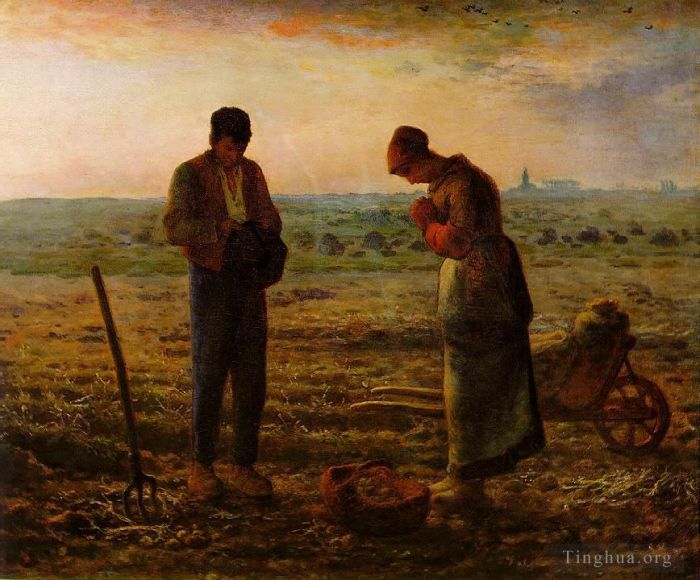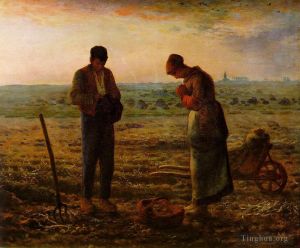The Angelus
Jean-Francois Millet
- Price: Price on Request
- Art Type: Oil Painting
- Size:
- English Comments: 0
- International Comments: 0
- Creating Date:
- Introduction and Works of Jean-Francois Millet >>
Keywords:
Angelus
Work Overview
- The Angelus
Jean-François Millet (1814-1875)
Between 1857 and 1859
Oil on canvas
H. 55.5; W. 66 cm
(Musée d'Orsay) / Hervé
A man and a woman are reciting the Angelus, a prayer which commemorates the annunciation made to Mary by the angel Gabriel. They have stopped digging potatoes and all the tools used for this task – the potato fork, the basket, the sacks and the wheelbarrow – are strewn around them. In 1865, Millet said: "The idea for The Angelus came to me because I remembered that my grandmother, hearing the church bell ringing while we were working in the fields, always made us stop work to say the Angelus prayer for the poor departed". So it was a childhood memory which was behind the painting and not the desire to glorify some religious feeling; besides Millet was not a church-goer. He wanted to catch the immutable rhythms of peasant life in a simple scene. Here he has focused on a short break, a moment of respite.
Alone in the foreground in a huge empty plain, the two peasants take on a monumental quality, despite the small size of the canvas. Their faces are left in shadow, while the light underlines their gestures and posture. The canvas expresses a deep feeling of meditation and Millet goes beyond the anecdote to the archetype.
Perhaps that explains the extraordinary destiny of The Angelus: it triggered an unbelievable rush of patriotic fervour when the Louvre tried to buy it in 1889, was venerated by Salvador Dali, lacerated by a madman in 1932 and became a world-famous icon in the 20th century.
The painting was commissioned by Thomas Gold Appleton, an American art collector based in Boston, Massachusetts. Appleton previously studied with Millet's friend, the Barbizon painter Constant Troyon. It was completed during the summer of 1857. Millet added a steeple and changed the initial title of the work, Prayer for the Potato Crop to The Angelus when the purchaser failed to take possession of it in 1859. Displayed to the public for the first time in 1865, the painting changed hands several times, increasing only modestly in value, since some considered the artist's political sympathies suspect. Upon Millet's death a decade later, a bidding war between the US and France ensued, ending some years later with a price tag of 800,000 gold francs.
The disparity between the apparent value of the painting and the poor estate of Millet's surviving family was a major impetus in the invention of the droit de suite, intended to compensate artists or their heirs when works are resold.
L'Angelus, painted in 1859, depicts a man and a woman praying to the bells of Angelus, the church near their home. The peasants must work instead of attending church, but still make time to pray. The upper class appears in the background of the painting, in a blur. However, Millet has colored the peasants to look like the ground, portraying them as part of the earth and thus, closer to God. L'Angelus was intended as a social criticism, for the peasants are made to look holy, while the rich upper class is hardly visible in the painting.
Arguably Millet's best-known work, The Angelus depicts a man and a woman standing in the foreground, with heads bowed, the man holds his hat in his hands, and the woman folds her hands in prayer. The man's pitchfork rests in the earth beside him, and, behind the woman, a small cart contains sacks of harvested potatoes. A basket of potatoes rests on the ground between the couple and potatoes dapple the earth at their feet. The sun is setting, but in the distance where a church steeple and part of a village are visible the sky still shows daylight.
In Roman Catholic villages of the time, the church bells would ring out three times daily, at 6 a.m., at noontime, and at 6 p.m. for the prayer (called the Angelus), and it is at such a moment that the couple stops their work to pray. Despite their humble circumstances, this simple act of devotion and the sculptural quality of their figures lends them a kind of quiet dignity, yet their worn clothes, and their bowed shoulders suggest a life of earthly toil. The gathering dusk engulfs them suggesting the difficulty and perhaps despair of their struggle, the Angelus, their prayer for deliverance, and the sky beyond still lit by the sun stands in stark contrast, punctuated by the steeple connecting Heaven and Earth, the ultimate goal of their struggle and their faith.
Revisiting a subject that he depicted in The Potato Harvest of 1855, Millet painted this work as a commission for a Boston art collector. Originally called Prayer for the Potato Crop, Millet changed the title and added a church steeple to the work, when the collector failed to purchase it in 1859. The work influenced Vincent van Gogh's The Potato Eaters of 1885, and served as a catalyst for his return to painting, so great was his admiration. For the artist Salvador Dalí, it became a kind of artistic obsession, recreating the scene many times in the 1930s, and in his book The Tragic Myth of The Angelus of Millet, (1938) argued that the couple had actually been praying over their buried child and that the work contained a message of repressed sexual aggression. Dalí's certainty may have been cemented by the words of the Angelus itself, which essentially condenses the Incarnation of Christ into three short prayers, one for each time of day, followed by the Hail Mary. The prayer for the evening is: 'And the Word was made flesh: and dwelt among us.' In 1963, in response to Dalí's repeated assertions, the Louvre x-rayed the painting revealing an underlying geometric shape similar to that of a coffin in the place where the farmer was now digging potatoes. Regardless of Millet's intention or Dalí's beliefs, there is an awareness of humanity's fall from grace where, having sinned, Adam and Eve were condemned to 'earning one's bread by the sweat of one's brow,' and where redemption existed only in the distant realm of heaven.
Compositionally, The Angelus is laid out in Millet's by-now-familiar format: the main subject is located in the foreground of the picture plane, while ancillary features are located in the far background, and little exists in between. As with Millet's other paintings such compositional strategy is reminiscent of works from the Italian Renaissance. Artists such as Giotto, Leonardo Da Vinci, and Raphael utilized this same strategy, along with the use of atmospheric perspective and diminution of figures to indicate deep special recession. But, while Renaissance artists became known for their pyramidal figure arrangement, Millet's are arranged horizontally as if on a stage, a souvenir of eighteenth century Neoclassical artists like Jacques-Louis David.
- Copyright Statement:
All the reproduction of any forms about this work unauthorized by Singing Palette including images, texts and so on will be deemed to be violating the Copyright Laws.
To cite this webpage, please link back here.
- >> English Comments
- >> Chinese Comments
- >> French Comments
- >> German Comments
- >>Report
- The Walk to Work Le Depart pour le Travail
- Autumn Landscape with a Flock of Turkeys
- Norman Milkmaid
- Harvesters Resting Ruth and Boaz
- Faggot Carriers
- Portrait of a Man
- The Angelus
- Leconte de Lisle
- Pastures In Normandy
- Vert The Nuns Parrot
- Woman with a Rake
- Shepherdess with Her Flock
- Dandelions
- In the Garden
- Peasant Spreading Manure
- Landscape With Two Peasant Women
- Couseuse Endormie
- Louise Antoinette Feuardent GTY
- Garden TGT
- Portrait Of Eugene Canoville
- Man with a Hoe
- Spring
- Haystacks Autumn
- The Sower
- The Gleaners
- The Bather
- Young Woman
- Un Tailleur De Pierres
- Composition de F Millet
- Landscape Hillside in Gruchy Normandy
- Portrait Of A Man Said To Be Leopold Desbrosses
- The Drunkeness Of Noah
- The Flight into Egypt
- Fishermen
- Shepherdesses Seated In The Shade
- Femme Etandant Sonlinge
- A Shepherdess And Her Flock
- Garden Scene
- Le Nourrisson or Lenfant Malade
- Bucheron Preparant Des Fagots









 Singing Palette
Singing Palette